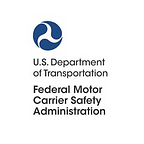Wearing a safety belt is the simplest and most effective way to stay safe on the road, yet many commercial truck drivers (or drivers of large trucks) don’t do it.[1] When safety belts are not used, the potential for crash-related injuries and death increases dramatically. For example, an unrestrained 15-passenger-van occupant involved in a single-vehicle crash is approximately four times more likely to be killed than a restrained occupant.[2]
In 2021, 63 percent of truck drivers killed in crashes of large trucks were not wearing a safety belt, down from 74 percent in 2020 but up from 59 percent in 2019. 2021 had more fatal crashes than the previous four years.
How safety belts help protect drivers
In a crash, a safety belt keeps the driver in place behind the steering wheel and in control of the vehicle while the vehicle absorbs the impact of the crash and decelerates, which prevents or reduces the consequences of an accident. Safety belts, especially lap-shoulder belts, spread the stress and impact forces of a crash along the stronger and broader areas of the body, such as the hips and shoulders, limiting injuries and minimizing the possibility of truck occupants striking the steering wheel, shift lever, windshield, other objects, and other occupants.
Myth vs. fact: 7 reasons for safety belt use
Refusing to use your safety belt is like refusing a free insurance policy. Buckling your safety belt only takes a few seconds, and it could save your life or prevent serious injury to yourself and others.
Myth #1: Wearing a safety belt is a personal decision that doesn’t affect anyone else.
Fact: Crash-related injuries attributable to not wearing a safety belt can affect a driver’s livelihood and they can have a tremendous emotional and financial impact on the driver’s family. It can also affect other road users, since wearing a safety belt can help you avoid losing control of your truck and crashing into others. It is also the law — federal regulations require commercial vehicle drivers to buckle up.
Myth #2: Safety belts prevent your escape from a burning or submerged vehicle.
Fact: Safety belts can keep you from being knocked unconscious, improving your chances of escape. Fire or submersion occur in less than five percent of fatal large truck crashes.
Myth #3: A large truck will protect you. Safety belts are unnecessary.
Fact: In 2021, 669 drivers of large trucks died in crashes. Of those, 31 percent were not wearing a safety belt.[3]
Myth #4: Safety belts are not necessary at lower speeds.
Fact: In a frontal collision occurring at 30 mph, the vehicle hits an object (another vehicle, tree, etc.) and stops. Unrestrained people and objects inside the vehicle continue to move forward until they hit the windshield, steering column, dashboard, roof of the vehicle, etc. at about 30 mph. This is the same velocity a person falling from the top of a three-story building would experience upon impact with the ground.
Myth #5: Good truck drivers don’t need to wear safety belts.
Fact: Good drivers usually do not cause collisions, but during your career you may be involved in a crash caused by another driver, bad weather, mechanical failure, or tire blowout. Wearing a safety belt prevents injuries and fatalities, reduces the chances of ejection, and helps protect your head and spinal cord from impact damage.
Myth #6: It takes too much time to fasten your safety belt 20 times a day.
Fact: Buckling up takes about three seconds. This means that even buckling up 20 times a day requires only one minute. It takes only an instant to die or become permanently injured.
Myth #7: It is better to be thrown clear in the event of a crash.
Fact. An occupant of a vehicle is four times as likely to be killed when ejected from the vehicle.[4]
Your family and community depend on you
Crash-related injuries attributable to not wearing a safety belt can affect a driver’s livelihood, and they can have a tremendous emotional and financial impact on the driver’s family. Your community also depends on you. Professional drivers contribute to public safety by setting a good example for other drivers. Drivers of large trucks who develop good safety practices are likely to carry these habits over to their off-duty driving situations and to other members of their families and communities.
[1] A large truck is defined as a truck with gross vehicle weight rater greater than 10,000 pounds.
[2] https://www.nhtsa.gov/vehicle-safety/15-passenger-vans
[3] https://www.iihs.org/topics/fatality-statistics/detail/large-trucks
[4] https://www.nhtsa.gov/vehicle-safety/15-passenger-vans
